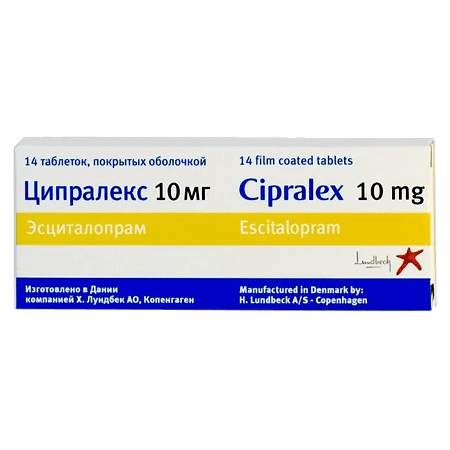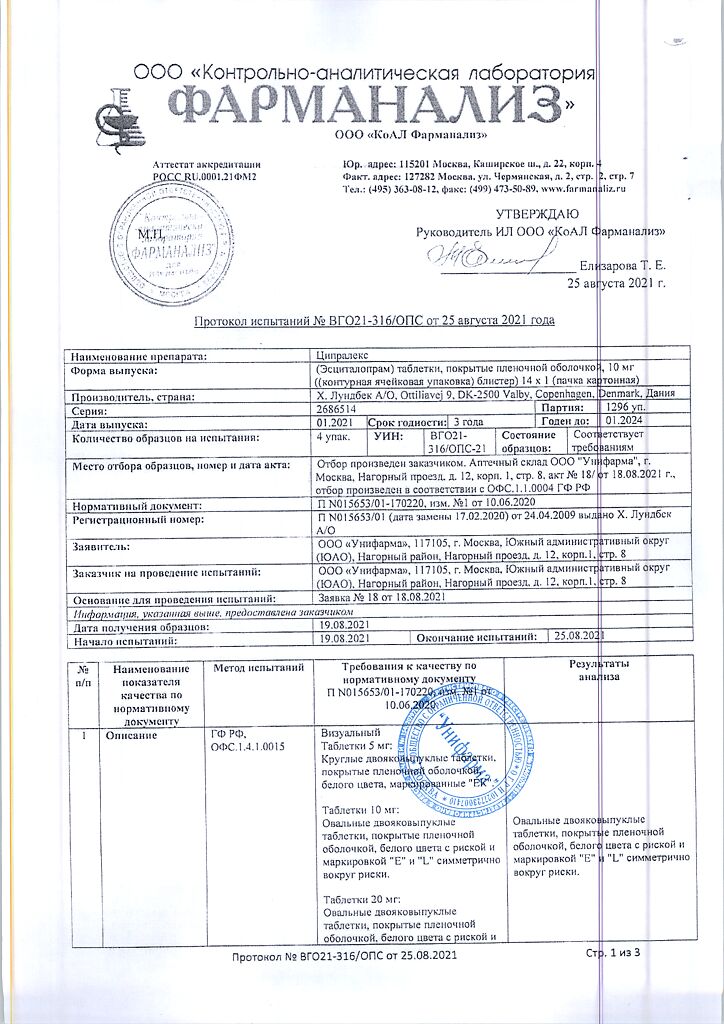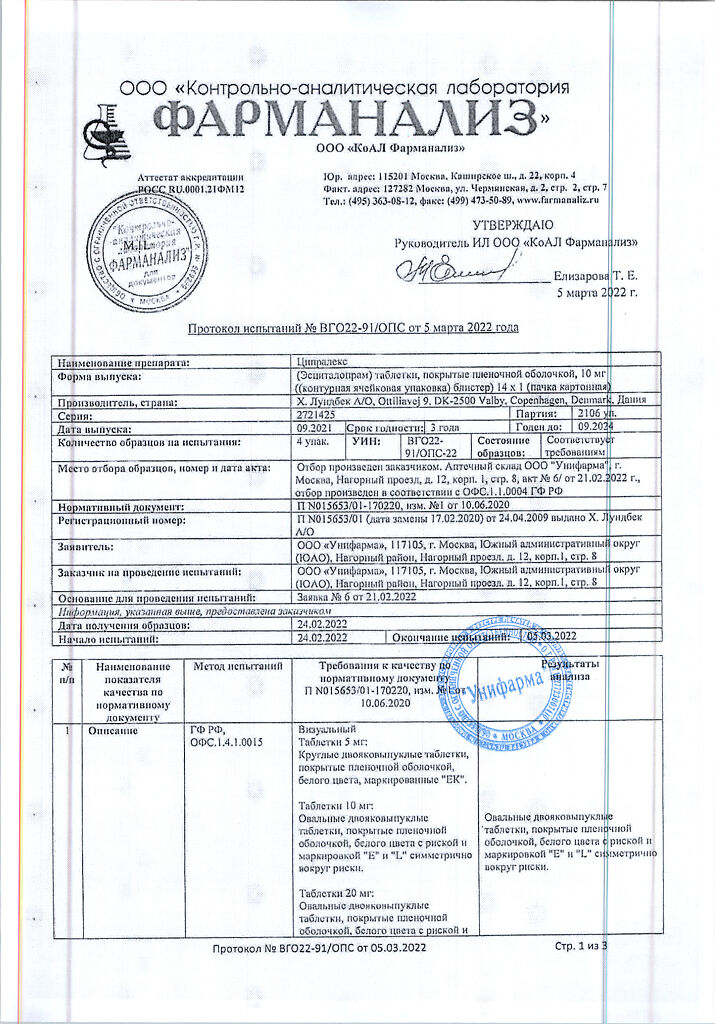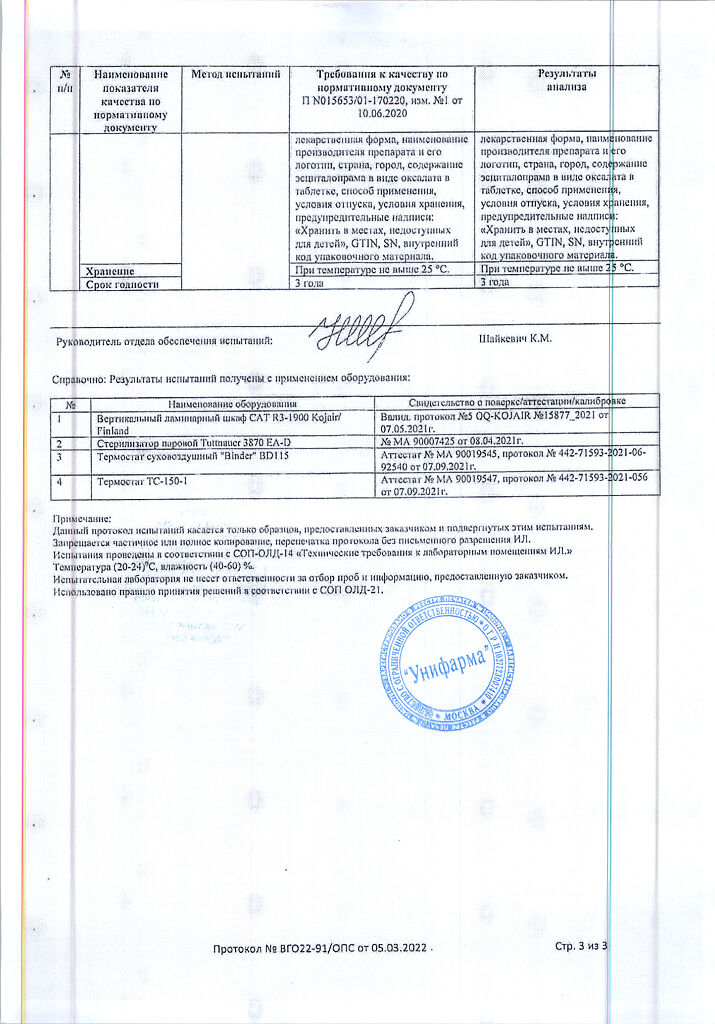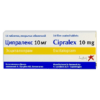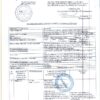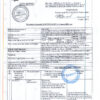No products in the cart.
Cipralex, 10 mg 14 pcs
€44.55 €37.13
Description
Cipralex has antidepressant effects.
Pharmacodynamics
Escitalopram is an antidepressant, SSRI, with high affinity for the primary binding site. Excitalopram also binds to the allosteric binding site of the transporter protein, with an affinity that is a thousand times lower. Allosteric modulation of the transporter protein enhances the binding of escitalopram at the primary binding site, resulting in a more complete inhibition of serotonin reuptake.
Escitalopram has no or very weak ability to bind to a number of receptors, including: serotonin 5-HT1A-, 5-HT2-receptors, dopamine D1– and D2-receptors, α1-, α2-, β-adrenoreceptors, histamine H1-receptors, m-cholinoreceptors, benzodiazepine and opioid receptors.
Pharmacokinetics
Intake is almost complete and independent of food intake. Mean Tmax in plasma is 4 hours after repeated administration. Absolute bioavailability of escitalopram is about 80%.
The apparent Vd after oral administration is 12 to 26 L/kg. The binding of escitalopram and its major metabolites to plasma proteins is below 80%.
Escitalopram is metabolized in the liver to demethylated and didemethylated metabolites. They are both pharmacologically active. Nitrogen can be oxidized to the metabolite N-oxide. The main substance and its metabolites are partially excreted as glucuronides. After repeated use, the average concentration of demethyl- and didemethyl-metabolites is usually 28-31% and less than 5%, respectively, of the concentration of escitalopram. Biotransformation of escitalopram to a demethylated metabolite occurs primarily via the CYP2C19 isoenzyme. Some involvement of CYP3A4 and CYP2D6 isoenzymes is possible. In persons with weak activity of CYP2C19 isoenzyme, the concentration of escitalopram is twice as high as in cases with high activity of this isoenzyme. No significant changes in drug concentrations were found in cases with weak CYP2D6 isoenzyme activity.
The T1/2 after multiple administration is about 30 h. Clearance with oral administration is about 0.6 l/min. The main metabolites of escitalopram have a longer elimination half-life. Excitalopram and its major metabolites are excreted by the liver (metabolic route) and the kidneys; most are excreted as metabolites in the urine.
The kinetics of escitalopram are linear. Equilibrium concentration is reached after approximately 1 week. An average Css, 50 nmol/L (20 to 125 nmol/L), is reached at a daily dose of 10 mg.
Particular patient groups
Patients over 65 years of age. In the elderly, escitalopram is excreted more slowly than in younger patients. The amount of the substance in the systemic bloodstream, calculated using the pharmacokinetic index AUC, is 50% greater in the elderly than in young healthy volunteers.
Indications
Indications
depressive episodes of any severity;
panic disorder with or without agoraphobia;
social anxiety disorder (social phobia);
generalized anxiety disorder;
obsessive-compulsive disorder.
Pharmacological effect
Pharmacological effect
Cipralex has an antidepressant effect.
Pharmacodynamics
Escitalopram is an SSRI antidepressant with high affinity for the primary binding site. Escitalopram also binds to the allosteric binding site of the transporter protein, with an affinity one thousand times lower. Allosteric modulation of the transporter protein enhances the binding of escitalopram at the primary binding site, resulting in more complete inhibition of serotonin reuptake.
Escitalopram has no or very weak ability to bind to a number of receptors, including: serotonin 5-HT1A, 5-HT2 receptors, dopamine D1 and D2 receptors, α1, α2, β-adrenergic receptors, histamine H1 receptors, m-cholinergic receptors, benzodiazepine and opioid receptors.
Pharmacokinetics
Absorption is almost complete and does not depend on food intake. The average Tmax in blood plasma is 4 hours after repeated use. The absolute bioavailability of escitalopram is about 80%.
Apparent Vd after oral administration ranges from 12 to 26 l/kg. The binding of escitalopram and its main metabolites to plasma proteins is below 80%.
Escitalopram is metabolized in the liver to demethylated and didemethylated metabolites. They are both pharmacologically active. Nitrogen can be oxidized to the N-oxide metabolite. The main substance and its metabolites are partially released in the form of glucuronides. After repeated use, the average concentration of demethyl and didemethyl metabolites is usually 28–31% and less than 5%, respectively, of the concentration of escitalopram. Biotransformation of escitalopram into a demethylated metabolite occurs mainly through the CYP2C19 isoenzyme. Some involvement of CYP3A4 and CYP2D6 isoenzymes is possible. In individuals with weak activity of the CYP2C19 isoenzyme, the concentration of escitalopram is twice as high as in cases with high activity of this isoenzyme. Significant changes in the concentration of the drug in cases with weak activity of the CYP2D6 isoenzyme were not detected.
T1/2 after repeated use is about 30 hours. Oral clearance is about 0.6 l/min. The main metabolites of escitalopram have a longer half-life. Escitalopram and its main metabolites are excreted by the liver (metabolic pathway) and kidneys; most of it is excreted as metabolites in the urine.
The kinetics of escitalopram is linear. Equilibrium concentration is reached after approximately 1 week. Average Css, 50 nmol/l (range 20 to 125 nmol/l), is achieved with a daily dose of 10 mg.
Special patient groups
Patients over 65 years of age. In elderly patients, escitalopram is eliminated more slowly than in younger patients. The amount of the substance in the systemic circulation, calculated using the pharmacokinetic AUC indicator, is 50% greater in the elderly than in young healthy volunteers.
Special instructions
Special instructions
Antidepressants should not be prescribed to children and adolescents under 18 years of age due to an increased risk of suicidal behavior (suicide attempts and suicidal thoughts), hostility (with a predominance of aggressive behavior, confrontational behavior and irritation). If a decision is made to initiate antidepressant therapy based on clinical assessment, the patient should be closely monitored.
Some patients with panic disorder may experience increased anxiety when starting antidepressant treatment. This paradoxical reaction usually disappears within the first 2 weeks of treatment. To reduce the likelihood of an anxiogenic effect, it is recommended to use low initial doses.
Escitalopram should be discontinued in the event of the primary development of convulsive seizures or an increase in their frequency (in patients with previously diagnosed epilepsy). SSRIs should not be used in patients with unstable epilepsy; Controlled seizures require careful monitoring.
Escitalopram should be used with caution in patients with a history of mania/hypomania. If a manic state develops, escitalopram should be discontinued.
In patients with diabetes mellitus, treatment with escitalopram may change blood glucose concentrations. Therefore, dose adjustments of insulin and/or oral hypoglycemic drugs may be required.
Depression is associated with an increased risk of suicidal ideation, self-harm, and suicide (suicidal events). This risk persists until significant remission occurs. Since improvement may not be observed during the first few weeks of therapy or even longer, patients should be closely monitored until their condition improves.
General clinical practice shows that in the early stages of recovery the risk of suicide may increase.
Other psychiatric conditions for which escitalopram is prescribed may also be associated with an increased risk of suicidal events and events. In addition, these conditions may be a comorbidity in relation to a depressive episode. When treating patients with other mental disorders, the same precautions should be taken as when treating patients with a depressive episode. Patients with a history of suicidal behavior or patients with a significant level of suicidal thoughts before treatment are at greater risk for suicidal ideation or suicide attempts and should be closely monitored during treatment. A meta-analysis of placebo-controlled clinical trials of antidepressants in adult patients with mental disorders found that there is an increased risk of suicidal behavior in patients under 25 years of age when taking antidepressants compared with placebo. Drug treatment of these patients, and in particular those at high risk for suicide, should be accompanied by careful monitoring, especially early in treatment and during dose changes. Patients (and caregivers) should be warned to monitor for any signs of clinical worsening, suicidal behavior or ideation, or unusual changes in behavior, and to seek immediate medical advice if these symptoms occur.
SSRI/SNRI use is associated with the development of akathisia, characterized by the development of subjectively unpleasant or distressing restlessness and a need for constant movement, often combined with an inability to sit or stand quietly. This most often occurs during the first few weeks of treatment. In patients with such symptoms, increasing the dose may lead to worsening.
Hyponatremia, possibly associated with impaired ADH secretion, occurs rarely with SSRIs and usually disappears when therapy is discontinued. Caution should be exercised when prescribing escitalopram and other SSRIs to persons at risk of developing hyponatremia: the elderly, patients with cirrhosis, and those taking drugs that can cause hyponatremia.
Cases of skin hemorrhages (ecchymosis and purpura) have been reported when taking SSRIs. Escitalopram should be used with caution in patients taking oral anticoagulants and medications that affect blood clotting, as well as in patients with a tendency to bleed.
Because clinical experience with the concomitant use of SSRIs and electroconvulsive therapy (ECT) is limited, caution should be used when escitalopram and ECT are used concomitantly.
Combining escitalopram and MAO A inhibitors is not recommended due to the risk of developing serotonin syndrome.
Escitalopram should be used with caution concomitantly with drugs that have serotonergic effects, such as sumatriptan or other triptans, tramadol and tryptophan. In rare cases, patients taking escitalopram and other SSRIs concomitantly with serotonergic drugs have developed serotonin syndrome. Its development may be indicated by a combination of symptoms such as agitation, tremor, myoclonus and hyperthermia. If this occurs, concomitant treatment with SSRIs and serotonergic drugs should be discontinued immediately and symptomatic treatment initiated.
Alcohol. Escitalopram does not interact pharmacodynamically or pharmacokinetically with alcohol. However, as with other psychotropic drugs, the simultaneous use of escitalopram and alcohol is not recommended.
Impact on the ability to drive vehicles or operate machinery. Despite the fact that Cipralex does not affect intellectual functions and psychomotor activity, patients are not recommended to drive a car or operate machinery during the treatment period.
Active ingredient
Active ingredient
Escitalopram
Composition
Composition
1 film-coated tablet contains:
active ingredient:
escitalopram oxalate 12.77 mg (equivalent to 10 mg escitalopram, respectively),
excipients:
talc – 7 mg;
croscarmellose sodium – 4.5 mg;
MCC – 97.49 mg;
colloidal silicon dioxide – 1.99 mg;
magnesium stearate – 1.25 mg,
film shell:
hypromellose 5cP – 2.19 mg;
macrogol 400 – 0.2 mg;
titanium dioxide (E171) – 0.73 mg.
Pregnancy
Pregnancy
There are limited data on the use of escitalopram during pregnancy.
If escitalopram was continued during late pregnancy, especially in the third trimester, the newborn should be monitored. If escitalopram was continued until delivery or was stopped shortly before delivery, the newborn may develop withdrawal symptoms.
If the mother takes SSRIs/SNRIs in late pregnancy, the newborn may develop the following side effects: respiratory depression, cyanosis, apnea, convulsive disorders, temperature fluctuations, feeding difficulties, vomiting, hypoglycemia, hypertension, muscle hypotonia, hyperreflexia, tremor, increased neuro-reflex excitability, irritability, lethargic sleep, constant crying, drowsiness, poor sleep. These symptoms may occur due to withdrawal symptoms or serotonergic effects.
In most cases, such complications occur within 24 hours after birth. Escitalopram should only be taken during pregnancy when absolutely necessary and after a careful benefit/risk assessment. Evidence from epidemiological studies suggests that use of SSRIs during pregnancy, especially later in pregnancy, may increase the risk of developing persistent pulmonary hypertension in the newborn.
Escitalopram is expected to be excreted in breast milk, therefore breastfeeding is not recommended during treatment with escitalopram.
Contraindications
Contraindications
hypersensitivity to escitalopram and other components of the drug Cipralex;
simultaneous use of non-selective irreversible MAO inhibitors;
simultaneous use of pimozide;
childhood and adolescence (up to 18 years).
With caution: severe renal failure (Cl creatinine below 30 ml/min); mania and hypomania; pharmacologically uncontrolled epilepsy; severe suicidal behavior; diabetes mellitus; cirrhosis; tendency to bleed; simultaneous use with an MAO A inhibitor (moclobemide) and an MAO B inhibitor (selegiline), serotonergic drugs, drugs that lower the seizure threshold, lithium, tryptophan, drugs containing St. John’s wort, oral anticoagulants and other drugs that affect blood clotting, drugs that can cause hyponatremia, drugs metabolized with the participation of the CYP2C19 isoenzyme, ethanol; electroconvulsive therapy; old age; pregnancy; breastfeeding period.
Side Effects
Side Effects
Side effects most often develop in the 1st or 2nd week of treatment and then usually become less intense and occur less frequently as therapy is continued.
The following are side effects that occur with drugs belonging to the class of SSRIs and were noted with escitalopram. Information is presented based on data from placebo-controlled clinical trials and spontaneous reports. The frequency is indicated as: very often – ≥1/10; often – from ≥1/100 to
From the blood and lymphatic system: unknown – thrombocytopenia.
From the immune system: rarely – anaphylactic reactions.
From the endocrine system: unknown – insufficient secretion of ADH.
Metabolic and nutritional disorders: often – loss of appetite, increased appetite, weight gain; infrequently – weight loss; unknown – hyponatremia, anorexia.
From the mental side: often – anxiety, restlessness, unusual dreams, decreased libido, anorgasmia (in women); infrequently – bruxism, agitation, nervousness, panic attacks, confusion; rarely – aggression, depersonalization, hallucinations; unknown – mania, suicidal thoughts, suicidal behavior. Cases of suicidal thoughts and behavior have been reported while taking escitalopram and immediately after discontinuation of therapy.
From the nervous system: often – insomnia, drowsiness, dizziness, paresthesia, tremor; uncommon – taste disturbances, sleep disturbances, syncope; rarely – serotonin syndrome; unknown – dyskinesia, movement disorders, seizure disorders, psychomotor agitation/akathisia.
From the side of the organ of vision: infrequently – mydriasis (pupil dilation), visual impairment.
From the organ of hearing and labyrinthine disorders: infrequently – tinnitus (tinnitus).
From the cardiovascular system: infrequently – tachycardia; rarely – bradycardia; unknown – prolongation of the QT interval on the ECG, orthostatic hypotension.
From the respiratory system, chest and mediastinal organs: often – sinusitis, yawning; infrequently – nosebleeds.
From the gastrointestinal tract: very often – nausea; often – diarrhea, constipation, vomiting, dry mouth; infrequently – gastrointestinal bleeding (including rectal).
From the liver and biliary tract: unknown – hepatitis, impaired liver function.
From the skin and subcutaneous tissues: often – increased sweating; uncommon – urticaria, alopecia, rash, itching; unknown – ecchymosis, angioedema.
From the musculoskeletal and connective tissue side: often – arthralgia, myalgia.
From the kidneys and urinary tract: unknown – urinary retention.
From the reproductive system and mammary gland: often – impotence, impaired ejaculation; infrequently – metrorrhagia (uterine bleeding), menorrhagia; unknown – galactorrhea, priapism.
From the body as a whole and disorders at the injection site: often – weakness, hyperthermia; infrequently – swelling.
During the post-marketing period, cases of QT prolongation have been reported, mainly in patients with pre-existing heart disease. In double-blind, placebo-controlled ECG studies in healthy volunteers, the change from baseline QTc (corrected using the Fridericia formula) was 4.3 ms at a dose of 10 mg/day and 10.7 ms at 30 mg/day.
Epidemiological studies in patients aged 50 years and older have shown an increased risk of bone fractures in patients taking SSRIs and tricyclic antidepressants. The mechanism by which this risk occurs has not been established.
Withdrawal (especially abrupt) of SSRI/SNRI drugs often leads to withdrawal symptoms. The most common symptoms include dizziness, sensory disturbances (including paresthesia and sensations of current flow), sleep disorders (including insomnia and intense dreams), agitation or anxiety, nausea and/or vomiting, tremor, confusion, increased sweating, headache, diarrhea, palpitations, emotional instability, irritability, visual disturbances. As a rule, these effects are mild or moderate and disappear quickly, however, in some patients they may manifest themselves in a more acute form and/or for a longer period of time. It is recommended to gradually discontinue the drug by reducing its dose.
Interaction
Interaction
Pharmacodynamic interaction
Non-selective irreversible MAO inhibitors. Serious adverse reactions have been reported with concomitant use of SSRIs and non-selective irreversible MAO inhibitors, as well as when starting MAO inhibitors in patients who had recently stopped taking SSRIs. In some cases, patients developed serotonin syndrome. The use of escitalopram simultaneously with non-selective irreversible MAO inhibitors is prohibited. Escitalopram can be started 14 days after discontinuation of irreversible MAO inhibitors. Before starting to take non-selective irreversible MAO inhibitors, at least 7 days must pass after stopping taking escitalopram.
Reversible selective MAO A inhibitor (moclobemide). Due to the risk of developing serotonin syndrome, it is not recommended to use escitalopram simultaneously with the MAO A inhibitor moclobemide. If taking such a combination of drugs is considered clinically necessary, it is recommended to start with the lowest possible doses, as well as to conduct constant clinical monitoring of the patient’s condition. Escitalopram can be started at least one day after discontinuation of the reversible MAO A inhibitor moclobemide.
Irreversible MAO B inhibitor (selegiline). Due to the risk of developing serotonin syndrome, caution should be exercised when taking escitalopram concomitantly with the irreversible MAO B inhibitor selegiline.
Serotonergic drugs. Concomitant use with serotonergic drugs (eg tramadol, sumatriptan and other triptans) may lead to the development of serotonin syndrome.
Medicines that lower the seizure threshold. SSRIs may lower the seizure threshold. Caution is required when using simultaneous escitalopram with other drugs that lower the seizure threshold (tricyclic antidepressants, SSRIs, mefloquine, bupropion, tramadol and antipsychotic drugs (neuroleptics) – derivatives of phenothiazine, thioxanthene and butyrophenone).
Lithium, tryptophan. Since increased effects have been reported with concomitant use of SSRIs and lithium or tryptophan, caution is recommended when coadministering escitalopram with lithium and tryptophan.
St. John’s wort. The simultaneous use of SSRIs and drugs containing St. John’s wort (Hypericum perforatum) may lead to an increase in the number of side effects.
Anticoagulants and other drugs that affect blood clotting. Blood clotting disorders may occur with simultaneous use of escitalopram with oral anticoagulants and other drugs that affect blood clotting (for example, atypical antipsychotics and phenothiazine derivatives, most tricyclic antidepressants, acetylsalicylic acid and other NSAIDs, ticlopidine and dipyridamole). In such cases, careful monitoring of blood clotting is necessary when starting or ending therapy with escitalopram. Concomitant use with NSAIDs may lead to an increase in bleeding.
Pharmacokinetic interaction
The influence of other drugs on the pharmacokinetics of escitalopram. The metabolism of escitalopram is mainly carried out with the participation of the CYP2C19 isoenzyme. To a lesser extent, isoenzymes CYP3A4 and CYP2D6 may participate in metabolism. Metabolism of the main metabolite, demethylated escitalopram, appears to be partially catalyzed by the CYP2D6 isoenzyme.
The simultaneous use of escitalopram and omeprazole (inhibitor of the CYP2C19 isoenzyme) leads to a moderate (approximately 50%) increase in the concentration of escitalopram in the blood plasma.
The simultaneous use of escitalopram and cimetidine (an inhibitor of the isoenzymes CYP2D6, CYP3A4 and CYP1A2) leads to an increase (approximately 70%) in the concentration of escitalopram in the blood plasma.
Thus, the maximum possible dose of escitalopram should be used concomitantly with inhibitors of the CYP2C19 isoenzyme (for example, omeprazole, fluoxetine, fluvoxamine, lansoprazole, ticlopidine) and cimetidine. When taking escitalopram and the above drugs simultaneously, a dose reduction of escitalopram may be necessary based on clinical assessment.
Effect of escitalopram on the pharmacokinetics of other drugs. Escitalopram is an inhibitor of the CYP2D6 isoenzyme. Caution should be exercised when using escitalopram simultaneously with drugs metabolized by this isoenzyme and having a low therapeutic index, such as flecainide, propafenone and metoprolol (in cases of use in heart failure) or drugs primarily metabolized by CYP2D6 and acting on the central nervous system, such as antidepressants: desipramine, clomipramine, nortriptyline or antipsychotic drugs: risperidone, thioridazine, haloperidol. In these cases, dose adjustment may be required.
The simultaneous use of escitalopram and desipramine or metoprolol leads to a twofold increase in the concentration of the latter two drugs.
Escitalopram may slightly inhibit the CYP2C19 isoenzyme. Therefore, it is recommended to exercise caution during the simultaneous use of escitalopram and drugs metabolized by the CYP2C19 isoenzyme.
Overdose
Overdose
Data on overdose of escitalopram are limited, and many such cases have involved overdose of other drugs. In most cases, symptoms of overdose do not appear or are mild. Cases of overdose of escitalopram (without taking other drugs) with a fatal outcome are rare, in most cases there is also an overdose of other drugs.
Symptoms: mainly from the central nervous system (from dizziness, tremor and agitation to rare cases of serotonin syndrome, convulsive disorders and coma), from the gastrointestinal tract (nausea/vomiting), cardiovascular system (hypotension, tachycardia, prolongation of the QT interval and arrhythmia) and electrolyte imbalance (hypokalemia, hyponatremia).
Treatment: There is no specific antidote for the drug. Normal airway patency, oxygenation and ventilation of the lungs should be ensured. Gastric lavage should be performed and activated charcoal should be prescribed. Gastric lavage should be performed as soon as possible after taking the drug. It is recommended to monitor the performance of the heart and other vital organs and provide symptomatic and supportive therapy.
Storage conditions
Storage conditions
At a temperature not exceeding 25 °C
Shelf life
Shelf life
3 years
Manufacturer
Manufacturer
H. Lundbeck A/O, Denmark
Additional information
| Shelf life | 3 years |
|---|---|
| Conditions of storage | At a temperature not exceeding 25 °C |
| Manufacturer | Х. Lundbeck A/O, Denmark |
| Medication form | pills |
| Brand | Х. Lundbeck A/O |
Related products
Buy Cipralex, 10 mg 14 pcs with delivery to USA, UK, Europe and over 120 other countries.

